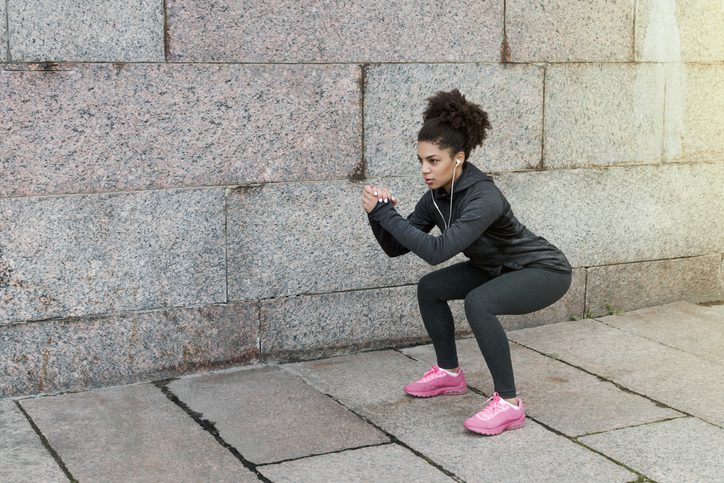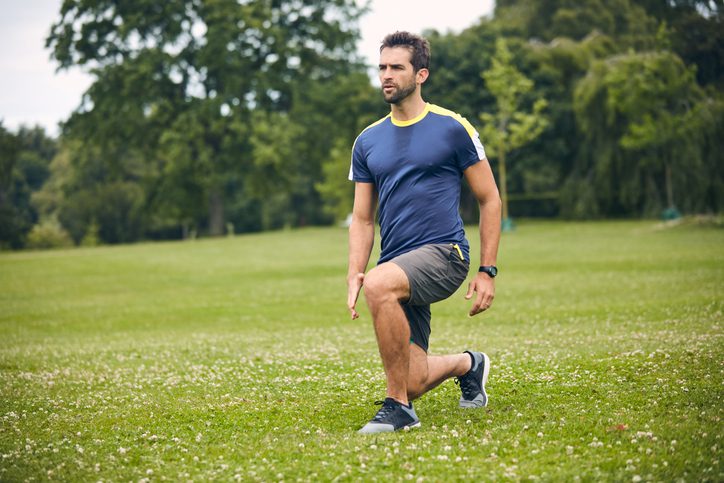4 exercises to build bulletproof knees
Strengthening the muscles that surround and support the knee will keep aches and pains at bay

We know that running doesn’t wreck your knees (and might even make them stronger) but newer runners or those making a comeback occasionally experience some soreness, and the knee is one of the most common areas of injury for runners. The easiest way to keep knee pain at bay is to beef up the muscles around the knee joint.
Adding a handful of simple exercises to your routine will help your legs provide better support and alignment, giving them the oomph they need to keep going strong while preventing common injuries, such as patellofemoral pain syndrome and runner’s knee. We have four exercises to help you get started.

Single-leg glute bridge
This exercise strengthens the glutes, hamstrings, and core while also improving hip stability and alignment.
Begin lying on the floor with your knees bent and hands by your side.
Engage your core and lengthen one leg out, keeping one foot on the floor. Push through your foot, slowly lifting your hips into a bridge position and keeping your one leg extended
Hold for a second at the top, squeezing your glutes and engaging your core muscles. Gently to the starting position. Aim for 10 repetitions, and then repeat on the other side.
Forward lunges
Lunges engage the quadriceps, hamstrings, glutes, and calf muscles, and activate stabilizing muscles such as the hip abductors and adductors. They improve overall stability and reduce stress on the knees.
Stand with your feet hip-width apart.
Take a step forward with one leg and lower your body until both knees are at a 90-degree angle, hovering the back knee just above the ground.
Push off the front foot to return to the starting position and repeat with the other leg. Aim for five to 10 repeats to start. You can build resistance by adding sets, or by holding weights once you become comfortable.
Step-ups with knee drive
Step-ups strengthen the muscles responsible for supporting the knee joint during weight-bearing activities like running and enhance the knee’s ability to withstand repetitive stress and maintain proper alignment, reducing the likelihood of overuse injuries.
Stand with feet hip-width apart, facing a step, box, or bench.
Step up with the right foot onto the box, and then drive the left knee up toward the chest. Aim for your hip and knee to form a 90-degree angle. Step back down and repeat on the other side. Aim for 3 sets of 10 reps on each side.
If you want more of a challenge, hold a light weight in the hand that is on the side doing the step-up (if you’re stepping up with your right leg, hold a weight in your right hand).
Squats
Squats strengthen the quadriceps muscles which directly connect to the knee. Strong quadriceps provide the knee with more stability, thus reducing and preventing injury. Start with two to three sets of eight to 12 repetitions.
Stand with your feet shoulder-width apart, toes slightly turned out, and your chest up.
Lower your body by bending your knees and pushing your hips back as if you’re sitting in a chair, keeping your weight on your heels.
Lower until your thighs are parallel to the ground, then push through your heels to return to the starting position, squeezing your glutes at the top.
As strength improves, you can gradually increase the number of sets, repetitions, or resistance (such as adding weights) to continue challenging the muscles and promoting knee strength.
Single-leg mini squat
This exercise mimics the motions of running, engaging all the major muscle groups involved in running to build strength and stability while It also challenges balance and building proprioception skills.
Begin by standing on one leg with your knee slightly bent. Keep your chest up, shoulders back and core engaged for balance.
Slowly lower your body by bending the knee of the leg you’re standing on, imagining that you’re sitting back in a chair. Keep your back straight, and go as low as you can (doesn’t need to be far!) while maintaining control.
Hold for a few seconds to challenge your balance and stability, and then push through the heel of the standing leg to return to the starting position. Try five-10 reps on each side to start.
As with any new activity, use caution and patience as you incorporate these into your routine. Feel free to modify by reducing the number of repetitions if you are struggling; if you’re very comfortable with lower-body strength training, add resistance by holding weights as you do the exercises.


